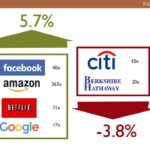BY JASON NORRIS AND MARY FAULKNER
It’s been a volatile year in equities and heading into the holiday season, it doesn’t look like these market extremes will dissipate.
It’s been a volatile year in equities and heading into the holiday season, it doesn’t look like these market extremes will dissipate
It’s been a volatile year in equities and heading into the holiday season, it doesn’t look like these market extremes will dissipate. After the 12-percent-market sell-off due to investors’ collective concerns regarding an impending Fed rate hike, China market crash, Greek debt issues and continuing geopolitical flare ups ― the S&P 500 has now rallied back to a roughly flat position for 2015. While 2014 proved to be a narrow market, 2015 has faced similar, if not a more challenging environment for identifying outperforming stocks. Looking at the 10 largest U.S. companies, a majority of them have performed significantly better than the S&P 500’s 1.4 percent gain, as of November 17, 2015.
What is even more compelling to note in this chart is that just three stocks were responsible for all of this return: Amazon, Alphabet/Google and Facebook.
If investors owned only the 10 largest stocks in the S&P 500, they would have performed meaningfully better than the broader index. The other 490 names performed very poorly in aggregate during this timeframe.
Over the years, we have seen periods of large-cap driven markets coupled with a handful of names driving that performance. But what we’ve experienced this year is less than a handful of mega-cap names delivering all the index returns.
Furthermore, this small list of market leaders has been dominated by “growth” stocks. The sell-off we experienced this summer was a classic “growth” scare. Investors believed that due to the strong dollar and slowdown in China, economic growth would also slow. While we’ve seen some stabilization in the equity market, there is still concern over the pace of global economic growth. Therefore, investors have been willing to “pay up” for growth companies and avoid cheaper names (i.e., “value” stocks) that are tied to the economy. For instance, the three stocks mentioned earlier trade at premiums to the overall market.
Investors are paying considerably more for $1.00 of earnings for a select few names due to their confidence in the company’s ability to deliver growth. This has resulted in growth stocks returning roughly 4 percent this year, while value stocks are down 5 percent.
Due to increasing wage gains, we believe that the U.S. consumer will spend over the holiday season. They may begin to take on some debt again as confidence continues to increase. This economic growth will likely result in the Federal Reserve raising rates in December, as well as stocks grinding higher. As growth accelerates in 2016, we will be looking for “value” in economically-sensitive names that have lagged.
The Coin Flip
From the global economy to what’s happening here in Oregon
Talking Turkey
As Oregonians review their investment portfolios or retirement plans at the end of the year, here are some tips that can keep your assets from affecting your holiday season.
There are many different styles of investing. Some managers pursue a growth strategy, which can result in more volatility. Others focus more on value, which can be viewed as weak performance during a bull market.
Regardless of where you land on December 31, 2015, it’s important to remember two important points. First, focus on your long-term goals and don’t sabotage your trajectory by “switching lanes.” We’ve all taken this approach in traffic and have rarely arrived at destination faster. Second, stay invested. Modifying your asset allocation to reflect your risk tolerance and time horizon make sense. Moving all of your assets to cash after reading a news headline or talking with your neighbor will eventually cause more harm than good.
As you can see from a study from Dalbar Associates, tactical moves made by individuals in their mutual funds can result in lower performance than seen by the S&P 500 and Barclay’s indices for stocks and bonds. Like cooking a turkey, it’s very hard to time the market right. But if you are patient and stick with the recipe you have selected, you will be rewarded when it’s time to sit down for Thanksgiving dinner.
- Jason Norris, CFA, is executive vice president of research and Mary Faulkner is senior vice president of branding and communications at Ferguson Wellman Capital Management. Ferguson Wellman is a guest blogger on the financial markets for Oregon Business.



